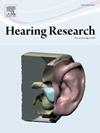BRCA1 deficiency promotes DNA damage in cochlear hair cells with activation of ATM-p53 pathway independent of CHK2
IF 2.5
2区 医学
Q1 AUDIOLOGY & SPEECH-LANGUAGE PATHOLOGY
引用次数: 0
Abstract
Platinum-based chemotherapy drugs, including cisplatin (CDDP), are known to cause irreversible hearing loss. We recently discovered that BRCA1 facilitates the repair of CDDP-induced DNA double-strand breaks (DSBs) in cochlear hair cells (HCs) and prevents hearing loss. However, the checkpoint pathways activated in response to DSBs in HCs, and the mechanisms by which Brca1 regulates these pathways, remain unclear. In this study, we demonstrate that CDDP induces significant DSBs in outer HCs (OHCs), accompanied by phosphorylation of ATM, CHK2, and p53 at serine‑15 (S15) and S20, leading to apoptosis. In contrast, CDDP induces fewer DSBs in inner HCs (IHCs), with phosphorylation of ATM and p53 at S20, but not CHK2, promoting cell survival. Brca1 deficiency further increases phosphorylation of ATM and p53 at S15 in CDDP-treated OHCs. In response to CDDP, phosphorylation of CHK2 is not detected, but phosphorylation of p53 at S20 is enhanced in Brca1-deficient OHCs, whereas, phosphorylation of p53 at S20 is significantly increased in both Brca1-deficient and proficient IHCs. The expression patterns of phosphorylated ATM, CHK2, and p53 in response to CDDP in cultured explants and cell lines differ markedly from those observed in Brca1-deficient and proficient mice in vivo. These findings suggest that CDDP induces extensive DSBs in OHCs, activating the ATM-CHK2-p53 pathway to promote cell death, while Brca1 deficiency exacerbates CDDP-induced DSBs and activates ATM-p53 signaling independent of CHK2, accelerating OHC loss. Additionally, these results demonstrate that CDDP induces modest DSBs in IHCs with activation of the ATM-p53 pathway, independent of CHK2 and BRCA1, leading to cell survival.
BRCA1缺乏通过激活独立于CHK2的ATM-p53通路促进耳蜗毛细胞的DNA损伤
以铂为基础的化疗药物,包括顺铂(CDDP),已知会导致不可逆的听力损失。我们最近发现BRCA1促进cddp诱导的耳蜗毛细胞(hc) DNA双链断裂(DSBs)的修复,并防止听力损失。然而,HCs中响应dsb而激活的检查点通路,以及Brca1调节这些通路的机制尚不清楚。在这项研究中,我们发现CDDP在外hc (OHCs)中诱导了显著的dsb,并伴随着ATM、CHK2和p53丝氨酸- 15 (S15)和S20的磷酸化,导致细胞凋亡。相比之下,CDDP在内hc (ihc)中诱导较少的dsb,在S20位点磷酸化ATM和p53,但不磷酸化CHK2,促进细胞存活。在cddp处理的OHCs中,Brca1缺失进一步增加了ATM和p53在S15位点的磷酸化。在CDDP的作用下,CHK2的磷酸化未被检测到,但p53在S20位点的磷酸化在brca1缺失的OHCs中增强,而p53在S20位点的磷酸化在brca1缺失和正常ihc中均显著增加。在体外培养的外植体和细胞系中,磷酸化的ATM、CHK2和p53对CDDP的表达模式与在brca1缺失和熟练小鼠体内观察到的表达模式明显不同。这些发现表明,CDDP在OHC中诱导广泛的DSBs,激活ATM-CHK2-p53通路,促进细胞死亡,而Brca1缺乏加剧了CDDP诱导的DSBs,激活了不依赖于CHK2的ATM-p53信号,加速了OHC的损失。此外,这些结果表明,CDDP通过激活独立于CHK2和BRCA1的ATM-p53通路,在ihc中诱导适度的dsb,从而导致细胞存活。
本文章由计算机程序翻译,如有差异,请以英文原文为准。
求助全文
约1分钟内获得全文
求助全文
来源期刊

Hearing Research
医学-耳鼻喉科学
CiteScore
5.30
自引率
14.30%
发文量
163
审稿时长
75 days
期刊介绍:
The aim of the journal is to provide a forum for papers concerned with basic peripheral and central auditory mechanisms. Emphasis is on experimental and clinical studies, but theoretical and methodological papers will also be considered. The journal publishes original research papers, review and mini- review articles, rapid communications, method/protocol and perspective articles.
Papers submitted should deal with auditory anatomy, physiology, psychophysics, imaging, modeling and behavioural studies in animals and humans, as well as hearing aids and cochlear implants. Papers dealing with the vestibular system are also considered for publication. Papers on comparative aspects of hearing and on effects of drugs and environmental contaminants on hearing function will also be considered. Clinical papers will be accepted when they contribute to the understanding of normal and pathological hearing functions.
 求助内容:
求助内容: 应助结果提醒方式:
应助结果提醒方式:


